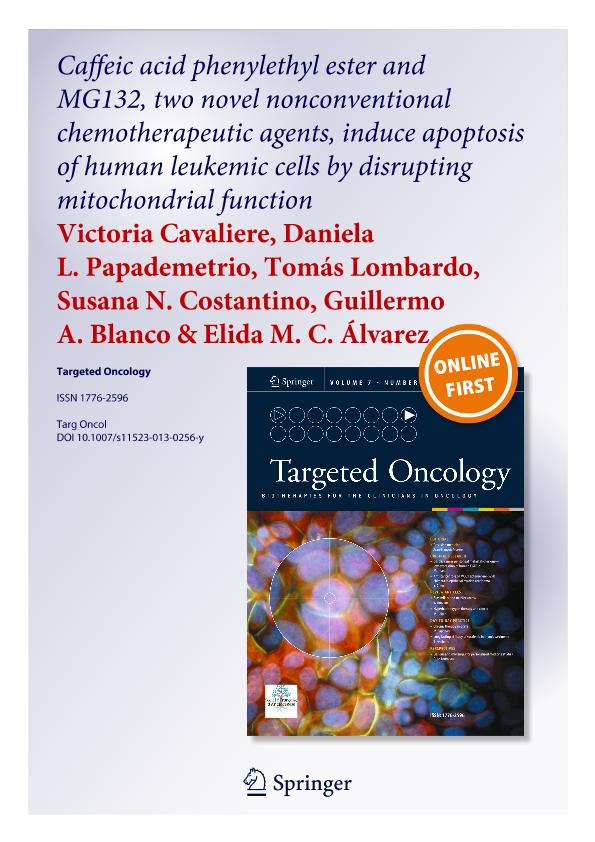Mostrar el registro sencillo del ítem
dc.contributor.author
Cavaliere, Victoria

dc.contributor.author
Papademetrio, Daniela Laura

dc.contributor.author
Lombardo, Tomás

dc.contributor.author
Costantino, Susana Nora

dc.contributor.author
Blanco, Guillermo Armando C.

dc.contributor.author
Alvarez Carbonetto, Elida M. del C.

dc.date.available
2016-11-08T16:26:14Z
dc.date.issued
2014-03
dc.identifier.citation
Cavaliere, Victoria; Papademetrio, Daniela Laura; Lombardo, Tomás; Costantino, Susana Nora; Blanco, Guillermo Armando C.; et al.; Caffeic acid phenylethyl ester and MG132, two novel nonconventional chemotherapeutic agents, induce apoptosis of human leukemic cells by disrupting mitochondrial function; Springer; Targeted Oncology; 9; 1; 3-2014; 25-42
dc.identifier.issn
1776-2596
dc.identifier.uri
http://hdl.handle.net/11336/8048
dc.description.abstract
The ability to modulate balance between cell survival and death is recognized for its great therapeutic potential. Therefore, research continues to focus on elucidation of cell machinery and signaling pathways that control cell proliferation and apoptosis. Conventional chemotherapeutic agents often have a cytostatic effect over tumor cells. New natural or synthetic chemotherapeutic agents have a wider spectrum of interesting antitumor activities that merit in-depth studies. In the present work, we aimed at characterizing the molecular mechanism leading to induction of cell death upon treatment of the lymphoblastoid cell line PL104 with caffeic acid phenylethyl ester (CAPE), MG132 and two conventional chemotherapeutic agents, doxorubicine (DOX) and vincristine (VCR). Our results showed several apoptotic hallmarks such as phosphatidylserine (PS) exposure on the outer leaflet of the cell membrane, nuclear fragmentation, and increase sub-G1 DNA content after all treatments. In addition, all four drugs downregulated survivin expression. CAPE and both chemotherapeutic agents reduced Bcl-2, while only CAPE and MG132 significantly increased Bax level. CAPE and VCR treatment induced the collapse of mitochondrial membrane potential (∆ψm). All compounds induced cytochrome c release from mitochondrial compartment to cytosol. However, only MG132 caused the translocation of Smac/DIABLO. Except for VCR treatment, all other drugs increased reactive oxygen species (ROS) production level. All treatments induced activation of caspases 3/7, but only CAPE and MG132 led to the activation of caspase 9. In conclusion, our results indicate that CAPE and MG132 treatment of PL104 cells induced apoptosis through the mitochondrial intrinsic pathway, whereas the apoptotic mechanism induced by DOX and VCR may proceed through the extrinsic pathway.
dc.format
application/pdf
dc.language.iso
eng
dc.publisher
Springer

dc.rights
info:eu-repo/semantics/openAccess
dc.rights.uri
https://creativecommons.org/licenses/by-nc-sa/2.5/ar/
dc.subject
Cape
dc.subject
Mg132
dc.subject
Mitochondria
dc.subject
Leukemia
dc.subject.classification
Otras Ciencias de la Salud

dc.subject.classification
Ciencias de la Salud

dc.subject.classification
CIENCIAS MÉDICAS Y DE LA SALUD

dc.title
Caffeic acid phenylethyl ester and MG132, two novel nonconventional chemotherapeutic agents, induce apoptosis of human leukemic cells by disrupting mitochondrial function
dc.type
info:eu-repo/semantics/article
dc.type
info:ar-repo/semantics/artículo
dc.type
info:eu-repo/semantics/publishedVersion
dc.date.updated
2016-11-07T15:41:14Z
dc.journal.volume
9
dc.journal.number
1
dc.journal.pagination
25-42
dc.journal.pais
Alemania

dc.journal.ciudad
Berlín
dc.description.fil
Fil: Cavaliere, Victoria. Consejo Nacional de Investigaciones Cientificas y Tecnicas. Oficina de Coordinacion Administrativa Houssay. Instituto de Estudios de la Inmunidad Humoral "Profesor R. A. Margni"; Argentina
dc.description.fil
Fil: Papademetrio, Daniela Laura. Consejo Nacional de Investigaciones Cientificas y Tecnicas. Oficina de Coordinacion Administrativa Houssay. Instituto de Estudios de la Inmunidad Humoral "Profesor R. A. Margni"; Argentina
dc.description.fil
Fil: Lombardo, Tomás. Consejo Nacional de Investigaciones Cientificas y Tecnicas. Oficina de Coordinacion Administrativa Houssay. Instituto de Estudios de la Inmunidad Humoral "Profesor R. A. Margni"; Argentina
dc.description.fil
Fil: Costantino, Susana Nora. Consejo Nacional de Investigaciones Cientificas y Tecnicas. Oficina de Coordinacion Administrativa Houssay. Instituto de Estudios de la Inmunidad Humoral "Profesor R. A. Margni"; Argentina
dc.description.fil
Fil: Blanco, Guillermo Armando C.. Consejo Nacional de Investigaciones Cientificas y Tecnicas. Oficina de Coordinacion Administrativa Houssay. Instituto de Estudios de la Inmunidad Humoral "Profesor R. A. Margni"; Argentina
dc.description.fil
Fil: Alvarez Carbonetto, Elida M. del C.. Consejo Nacional de Investigaciones Cientificas y Tecnicas. Oficina de Coordinacion Administrativa Houssay. Instituto de Estudios de la Inmunidad Humoral "Profesor R. A. Margni"; Argentina
dc.journal.title
Targeted Oncology

dc.relation.alternativeid
info:eu-repo/semantics/altIdentifier/url/http://link.springer.com/article/10.1007%2Fs11523-013-0256-y
dc.relation.alternativeid
info:eu-repo/semantics/altIdentifier/doi/http://dx.doi.org/10.1007/s11523-013-0256-y
Archivos asociados
